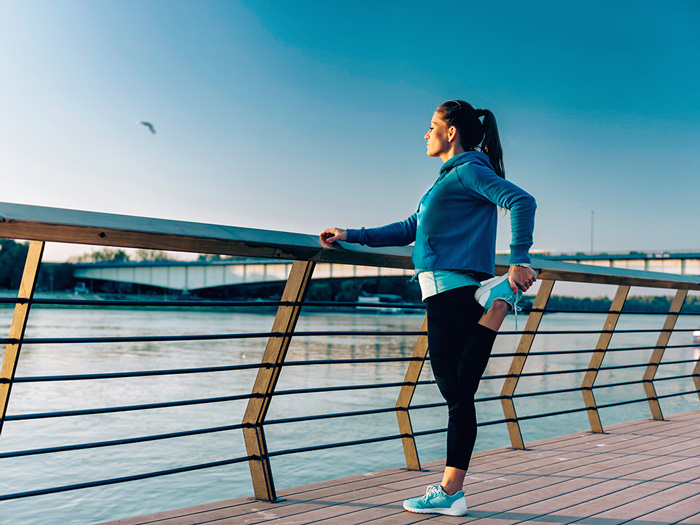Why is exercise good for you?
One primary reason is because movement increases the flow of endorphins, dopamine, and serotonin.
- Endorphins are essential hormones that promote feelings of pleasure and reduce pain. If you’re familiar with the term runner’s high, it’s in reference to the flood of endorphins produced in your body through intense exercise. They’re also called the “feel good” chemicals, because they’re part of your brain’s reward system.
- Dopamine is a neurotransmitter or chemical that’s also part of the pleasure and reward centers of your brain. It’s a messenger to nerves that helps us feel drive, bliss, motivation, pleasure, and focus. If dopamine is drained, this affects numerous aspects of brain function, such as behaviors, learning, and sleep patterns.
- Serotonin is a neurotransmitter used primarily for helping to regulate mood, stress, circadian rhythms, and memory. It’s also critical for proper cognition. But, serotonin isn’t only in the brain—it’s also responsible for a variety of other bodily functions, such as proper respiration and digestion, bladder control, body temperature, and metabolism.
Substance abuse creates an artificial environment in the brain’s pleasure and reward center and in the central nervous system. The same neurotransmitters you can easily boost with a daily 20-minute walk are severely compromised by drugs and alcohol.
If you’re trying to maintain a sober lifestyle, exercise is often a crucial component in your continuum of care plan. Once you go through detox and move into recovery, there’s still the challenge of dealing with:
- Cravings
- Energy fluctuations
- Mental health issues
- Negative emotions
- Potential weight gain
- Sleep disturbances
- Smoking during recovery, but wanting to quit
New theories in addiction treatment indicate that a combination of exercise and therapy may be helpful during recovery to prevent relapses and promote long-lasting wellness.
Choosing Forms of Exercise to Enjoy
Although we know exercise is good for us, sometimes it’s hard to get started and stick with a routine. Fortunately, there are a variety of options.
Strength training, running, swimming, cycling, dancing, or walking—there are numerous ways to establish a steady exercise program. You may find working with a personal trainer at the gym gives you better accountability, or maybe you’d like to join a Zumba class for the fun music and fast dance moves! The most important thing to remember is you’ll improve your chances of success by choosing an activity you enjoy.
Making time for exercise is as simple as scheduling one to three 10-minute brisk walks around the block each day. Come back home each time, stretch for five minutes, and your body and mind will receive a natural release of endorphins, dopamine, and serotonin essential to your continued recovery. There’s even an app that helps you achieve your 10-minute daily goal!
You can also choose something a little more specific to staying top-of-mind with your sobriety while incorporating gentle movement. Yoga of 12-Step Recovery is one approach. The Journal of Alternative and Complementary Medicine refers to studies that indicate a restorative yoga practice increases GABA, a brain chemical designed to reduce anxiety and your stress response. Many people often struggle with stress, depression, and anxiety during recovery, so perhaps yoga can help.
If you’re eager challenge yourself through exercise, Racing for Recovery may be the answer. Created by Todd Crandall, a “former addict turned Ironman triathlete”, his mission with this non-profit is “to prevent all forms of substance abuse by promoting a lifestyle of fitness and health for all those affected by addiction.” The organization has live streaming support groups, and facilitates one mile walks as well as 5K and 10K runs.
The Healing Properties of Exercising Outdoors
In the book Silent Spring, author Rachel Carson said: “Those who contemplate the beauty of the earth find reserves of strength that will endure as long as life lasts. There is something infinitely healing in the repeated refrains of nature—the assurance that dawn comes after night, and spring after winter.”
There are numerous physical benefits to exercising outside, including using changes in terrain to boost your hiking, running, or walking abilities, as well as benefiting from wind resistance for a boost in burned calories. In addition, muscles adapt differently working out in nature on different surfaces than in the gym on a treadmill.
More importantly, exercising outdoors has vital emotional and mental benefits. For example:
- You learn more about your neighborhood and your community. Taking advantage of a nearby walking trail, jogging around your neighborhood, or even riding your bike to work helps you see and be seen.
- You can develop more positive, face-to-face relationships and develop a sense of belonging by being an active part of what happens day-to-day.You can use exercise for family and group activity time. Chasing your kids around a park playground or basketball court will certainly work up a sweat! Plus, your example is the best way to teach them the importance of healthy habits. Helping to plant a community garden or joining a softball league extends the outreach of positive interactions, and creates social connections centered on wellness.
- You receive an instant mood boost. The American Council on Exercise shares research that outdoor exercise offers quantifiable benefits such as “feelings of revitalization and increased energy, plus decreased tension, confusion, anger, and depression.”
On our gorgeous 11-acre campus of wooded grounds, accented with lush gardens, towering oaks, and the calm waters of Lake Raymond, there are many opportunities to commune with nature and find peace. We also have other opportunities for both indoor and outdoor recreational therapy and exercise. Take a virtual tour to learn more.

